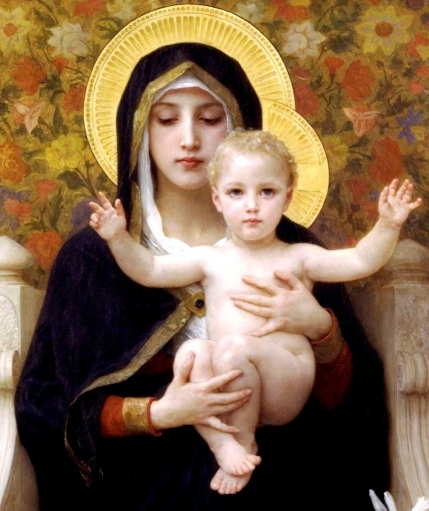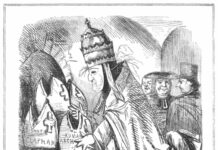I will surely multiply your pain in childbearing;
in pain you shall bring forth children. (Genesis 3:16)
Ironically, although technological advances have made it possible for the act of parturition (childbirth) itself to be relatively painless, no one can deny that the process of rearing children to be good and responsible members of society will contain a lot of pain, problems and challenges. The curses given to women and men, respectively—“In pain you shall bring forth children” (verse 16) and “through painful toil you will eat of the ground all the days of your life; it will produce thorns and thistles for you” (verses 17-18)—are actually one and the same: The presence of evil in this world has made the bearing or production of anything good and lasting in this world arduous, painful, and thorny.
Think of any good or lasting project, artistic work, organization, or business venture; in fact, think of anything good and lasting that will serve the betterment of society. I can guarantee that whatever the work or project is, it will have its fair share of challenges, of pain, of thorns and thistles. Whether it is the rearing of a biological child, or the nurturing of a brainchild or project to its full maturity—such that good and lasting fruits can be seen and felt by society at large—this process is only possible by the sweat of our brow, as a labour of love that often contains painful toil. In fact, the curses mentioned in Genesis are simply the byproduct of humanity’s choice to welcome Evil into the world. Ever since Evil made its entry into the world, all pursuit of lasting happiness, virtue and goodness has always been dogged by toil, thorns and thistles. Or, as Saint John Paul II aptly explained in his 1981 encyclical Laborem Exercens:
While it is true that man eats the bread produced by the work of his hands—and this means not only the daily bread by which his body keeps alive but also the bread of science and progress, civilization and culture—it is also
a perennial truth that he eats this bread by “the sweat of his face”, that is to say, not only by personal effort and toil but also in the midst of many tensions, conflicts and crises, which, in relationship with the reality of work, disturb the life of individual societies and also of all humanity.[1]
But another curse is given unto women: Your desire will be for your husband, and he will rule over you (Genesis 3: 16b). This curse is simply a byproduct of our mortality: Ever since mortality entered into our world, human beings in their physical nature have become no different from other living organisms, subject to death, degradation and decay. And women, who from the beginning were created by the Almighty to be Beautiful, suffer this degradation even more acutely. For the curse of mortality in time shall erode not only our health and vitality, but also all traces of physical beauty. This is why until now, billions of dollars are spent by women worldwide on products which promise to slow the process of aging and degradation, as well as enhance or prolong youthful beauty.
Even if a girl is not yet married, or doesn’t desire to get married, she is constantly forced by nature and society to be aware of her own potential for beauty and charm. Daily, her peers, the mass media, people around her and even her own instincts of preservation teach her to regard her youth and natural beauty as something precious and invaluable. How many girls suffer agonizing mental torments simply because some ignoramus calls her fat or ugly. How many spend their days focused on some imaginary ugliness or physical defect, simply due to the careless words of others! How many suffer from eating disorders and low self-worth, all simply because they desire to be regarded as beautiful and priceless. And how many suffer bullying and abuse at the hands of men who know how to manipulate this desire to be loved, to be regarded as precious and beautiful!
Within the hearts of all women is this desire to be regarded as precious and beautiful. Even if she is unmarried or doesn’t desire to get married, this desire is present and strong, and cannot be quenched. It is innate to our human nature, and especially so in women, who from the beginning were created to be beautiful. That is why so much suffering has resulted from the feeling that one is ugly, unwanted, unloved, and so on.
While Scripture mention some women such as Sarah[2], Hadassah/Esther[3] and Job’s daughters[4] to be physically beautiful, there is never any description or reference to the Blessed Virgin’s physical appearance. And yet, in various apparitions (such as in Lourdes and Fatima), she is always described by the visionaries as extraordinarily beautiful. Sometimes, the Blessed Virgin is portrayed as a European woman, while at other times, she is portrayed as a Hispanic woman (our Lady of Guadalupe), or even as an African or Chinese woman. No matter how she is depicted, our Lady is always portrayed as extraordinarily beautiful and youthful. Is this simply Marian “idolatry”, as many Protestants and seculars believe, or is there more here than meets the eye?
Catholics believe Mary to be the New Eve. Let us first consider what the old Eve (that is, the first woman) was like. For sure, Eve was extraordinarily beautiful physically, more so than any other woman that has ever been born in this world. She was created before the age of Mortality, before the flesh was subject to shame, decay, sickness, aging, death or any kind of degradation. Physically, Eve was perfect, more so than any other woman that has ever lived.
And yet, it was through Eve’s willfulness and distrust of God’s goodness that Death and suffering entered the world, making her not beautiful in her inner self. By contrast, our Lady is perfectly beautiful on the inside: She is all glorious within[5], and immaculate. That is how she was able to respond to the angel Gabriel: Behold, I am the handmaiden of the Lord; let it be to me according to your word[6].
But how does she appear physically? Does she have African or European features? Is she flat chested or full-bosomed? Is she tall or short, thin or plump? None of this matters under the New Covenant. For behold, the child that she bore, our Lord Christ, had no beauty or majesty to attract us to him, nothing in his appearance that we should desire him[7]. He, the Omnipotent King, Rich and Glorious beyond all worlds, has come in poverty, in meekness, in hunger and in thirst, so that we through his poverty might become rich[8]. It is as if He took on the mantle of our infirmities, the curse of our mortality and all its sufferings, in order that we may share in His Divine nature, and be co-heirs with Him in the Father’s everlasting Kingdom[9].
And in this New Covenant, this New and eternal Testament of Love, He has instituted a new standard of Beauty, the kind that will never fade. As Scriptures testify:
Your beauty should not come from outward adornment, such as elaborate hairstyles and the wearing of gold jewelry or fine clothes. Rather, it should be that of your inner self, the unfading beauty of a gentle and quiet spirit, which is of great worth in God’s sight[10].
So great is the worth of this new, glorious and unfading beauty ushered by the New Covenant, for it reflects the Spirit and Majesty of our King.
In your majesty ride forth victoriously
in the cause of truth, humility and justice;
let your right hand achieve awesome deeds. (Psalm 45:4)
Listen, daughter, and pay careful attention:
Forget your people and your father’s house.
Let the King be enthralled by your beauty;
honor Him, for he is your Lord. (Psalm 45:10-11)
For you know that it was not with perishable things such as silver or gold that you were redeemed from the empty way of life handed down to you from your ancestors, but with the precious blood of Christ, a lamb without blemish or defect. He was chosen before the creation of the world, but was revealed in these last times for your sake. (1 Peter 1:18-20)
In fact, in proclaiming Mary to be a mystical Rose, a house of gold and the Queen of Angels[11], the Church—as the Bride of Christ—is in fact proclaiming and ushering in a new, unfading kind of Beauty, Majesty and Glory. For just as the King of kings lived ‘in disguise’ while He was in this world (i.e. His beauty, majesty, glory and kingliness not being readily visible), so too do we live ‘in disguise’ while we are in this world. Just like the Holy Family and the apostles, our appearances and daily activities may look thoroughly mundane or even disgraceful in the eyes of the world. And yet, we are to put no confidence in the flesh[12], in worldly standards of beauty that tells us to look up to some women while looking down on others. Rather, with expectant hearts we look forward to the Heavenly Jerusalem, that Bride of Christ that will be revealed in all her majestic glory at the Consummation of Time[13]. While still in this world, we are like a garden locked up, a spring enclosed, a sealed fountain[14]. Like our Mother the Blessed Virgin, our beauty may not be readily visible to mortal eyes. Like the King of kings, our Brother, Friend and Savior, we may be despised and rejected, familiar with suffering[15]. And yet, we know who we really are: In His eyes, we are infinitely beautiful, beloved and priceless. For in His love He has united himself to us to such an extent, that we have become the very members of His Body:
After all, no one ever hated his own body, but he feeds and cares for it, just as Christ does the Church—for we are members of his Body[16].
This is a profound mystery—but I am talking about Christ and the Church[17].
Be imitators of God, therefore, as dearly loved children and live a life of love, just as Christ loved us and gave himself up for us as a fragrant offering and sacrifice to God[18].
For he has rescued us from the dominion of darkness and brought us into the kingdom of the Son he loves, in whom we have redemption, the forgiveness of sins[19].
So we fix our eyes not on what is seen, but on what is unseen, since what is seen is temporary, but what is unseen is eternal[20].
Mary, then, is the Liberator of Women. As daughters of Mary, women know themselves to be infinitely beautiful and precious, and especially so if they fix their eyes on Christ, just as Mary had done. As daughters of Mary, we can forget the arbitrary gaze and appraisal of this world, and let the King be enthralled by our beauty—the unfading beauty and majesty that He has given us in His infinite Love.
Audrey YU Jia Hui
Shanghai, PRC, June 2017
[1] http://w2.vatican.va/content/john-paul-ii/en/encyclicals/documents/hf_jp-ii_enc_14091981_laborem-exercens.html
[2] Genesis 12:11
[3] Esther 2:7
[4] Job 42:15
[5] Psalm 45:13
[6] Luke 1:38
[7] Isaiah 53:2
[8] 2 Corinthians 8:9
[9] Romans 8:16-17, 2 Corinthians 3:17-18
[10] 1 Peter 3:3-4
[11] Litany of Loreto
[12] Philippians 3:3, 2 Corinthians 5:16-17
[13] Revelation 21:2, 15-27
[14] Songs 4:12 (traditionally seen as referring to our Lady)
[15] Isaiah 53:3, John 15:15, Romans 8:28-30, Hebrews 2:10-18.
[16] Ephesians 5:29-30
[17] Ephesians 5:32
[18] Ephesians 5:1
[19] Colossians 1:13
[20] 2 Corinthians 4:18











